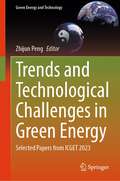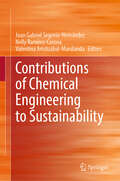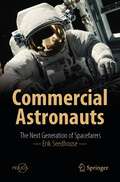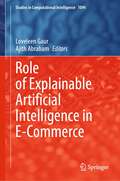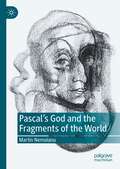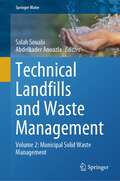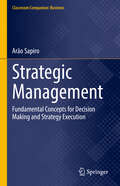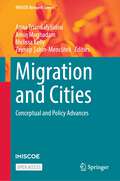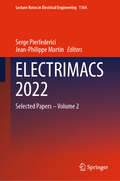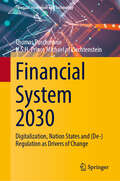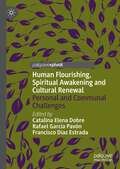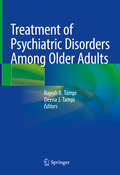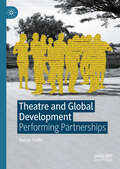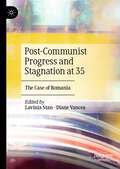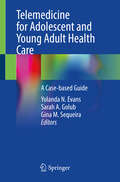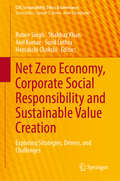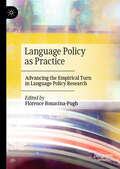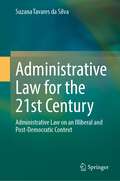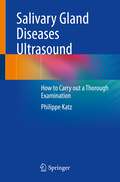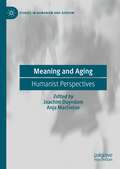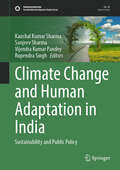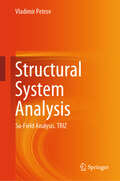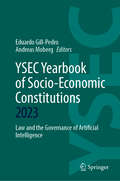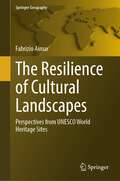- Table View
- List View
Trends and Technological Challenges in Green Energy: Selected Papers from ICGET 2023 (Green Energy and Technology)
by Zhijun PengTrends and Technological Challenges in Green Energy: Selected Papers from ICGET 2023 offers readers selected and expanded papers from the 2023 8th International Conference on Green Energy Technologies held at the University of the Applied Sciences in Hamburg, Germany. It features innovative work by academics, researchers, and industry experts highlighting the latest renewable energy developments. The book covers fundamental and practical applications for green energy resources, including security, energy consumption, localization, energy access, environment-friendly energy systems, sustainable energy development, energy-saving technologies, and conservation. It is a valuable interdisciplinary reference for young researchers, postgraduate students, professionals, and industry practitioners working with green energy technology and applications.
Contributions of Chemical Engineering to Sustainability
by Juan Gabriel Segovia-Hernández Nelly Ramírez-Corona Valentina Aristizábal-MarulandaThis book discusses the recent advancements in chemical engineering and their role in achieving the United Nations' 2030 Agenda and Sustainable Development Goals (SDGs). Addressing these goals involves tackling intricate and interdisciplinary challenges.Chemical engineers have been diligently addressing a diverse array of issues across academia, society, and industry, with the aim of positively impacting these goals.The book offers essential insights and detailed analyses for each SDG. It explores the challenges encountered within various applications and proposes solutions based on foundational engineering principles. The book's content is tailored to professionals, students, and researchers across diverse fields, including engineering, environmental science, and biotechnology.
Commercial Astronauts: The Next Generation of Spacefarers (Springer Praxis Books)
by Erik SeedhouseThe beginning of the 2020’s witnessed dozens of commercial astronauts fly to space on a variety of vehicles. These spacecraft included SpaceX’s Crew Dragon, which supported the Inspiration4 and Axiom Space missions, Virgin Galactic’s SpaceShipTwo, which supported several suborbital science flights, and Blue Origin’s New Shepard spacecraft, which not only flew celebrities but also its fair share of commercial astronauts. The story of this new breed of spacefarer has only just begun. As evidenced by these missions, commercial spaceflight has grown beyond passengers simply traveling to space just for the ride. With orbital flights involving commercial astronauts staying in space for several days and weeks, companies such as Sierra Space, Axiom Space and Blue Origin are preparing for the next steps in commercial space travel which include the construction of orbiting habitats. But how will the opportunities for commercial astronauts develop, how will they be trained, and will this new group of astronauts evolve? This book describes how the commercial spaceflight industry is evolving, how it will continue to evolve as barriers to entry are reduced, competition grows, and costs are lowered, and how, because of these efforts, opportunities for commercial astronauts will increase.
Role of Explainable Artificial Intelligence in E-Commerce (Studies in Computational Intelligence #1094)
by Ajith Abraham Loveleen GaurThe technological boom has provided consumers with endless choices, removing the hindrance of time and place. Understanding the dynamic and competitive business environment, marketers know they need to reinforce indestructible customer experience with the support of algorithmic configurations to minimize human intrusion. World Wide Web (WWW) and online marketing have changed the way of conducting business; with artificial intelligence (AI), business houses can furnish a customized experience to fulfil the perceived expectation of the customer.Artificial intelligence bridges the gap between business and prospective clients, provides enormous amounts of information, prompts grievance redressal system, and further complements the client’s preference. The opportunities online marketing offers with the blend of artificial intelligence tools like chatbots, recommenders, virtual assistance, and interactive voice recognition create improved brand awareness, better customer relationshipmarketing, and personalized product modification.Explainable AI provides the subsequent arena of human–machine collaboration, which will complement and support marketers and people so that they can make better, faster, and more accurate decisions. According to PwC’s report on Explainable AI(XAI), AI will have $15.7 trillion of opportunity by 2030. However, as AI tools become more advanced, more computations are done in a “black box” that humans can hardly comprehend. But the rise of AI in business for actionable insights also poses the following questions: How can marketers know and trust the reasoning behind why an AI system is making recommendations for action? What are the root causes and steering factors? Thus, transparency, trust, and a good understanding of expected business outcomes are increasingly demanded.
Pascal's God and the Fragments of the World
by Martin NemoianuIn Pascal's God and the Fragments of the World, Martin Nemoianu offers a new interpretation of the thought of Blaise Pascal, drawn from the Pensées and beyond. The book takes Pascal's central theme to be the distinction - Infini rien - between the transcendent God and the created world, which, without God, would be nothing. Nemoianu identifies the distinction in Pascal, articulates it, and works through the difficulties attending the distinction's disclosure. He then considers the implications of the distinction for the nature of nature and the nature of the human being, culminating in the ideal of martyrdom. The book closes with treatment of a closely related theme: the relation between human freedom and divine grace, in the context of the vexed question of Pascal's Jansenism.
Komorbidität: Symptome, Zustände, Verhalten und Behandlungen
by Einar Thorsteinsson Rhonda BrownDieses Buch stellt eine neue Theorie über die erhebliche Komorbidität vor, die zwischen vielen Krankheiten und Störungen und gleichzeitigen Symptomen wie Schmerzen, Schlafstörungen und Müdigkeit besteht. Zu den besprochenen Krankheiten und Störungen gehören Adipositas, Diabetes mellitus Typ II, medizinische Erkrankungen wie Herz-Kreislauf-Erkrankungen und Schlafstörungen, Essstörungen sowie affektive Störungen (Angst und Depression). Das Buch geht davon aus, dass die Komorbiditäten das Ergebnis eines komplexen bio-psycho-behavioralen Mechanismus sind, der eine Störung des zirkadianen Rhythmus einschließt. Es untersucht methodische (z. B. Mess-) Probleme, die das Verständnis der Komorbidität erschweren können, und erforscht ein breites Spektrum neuer, bestehender und neu entwickelter Therapieansätze, die bei der Behandlung komorbider Störungen von Nutzen sein könnten.
Technical Landfills and Waste Management: Volume 2: Municipal Solid Waste Management (Springer Water)
by Salah Souabi Abdelkader AnouzlaThis book examines the issue of solid waste generation and management as a worldwide phenomenon, focusing on strategies that facilitate the disposal and utilization of waste while ensuring environmental integrity and meeting the needs of future generations. The process of urbanization, particularly in densely populated cities, has resulted in a notable increase in the production of solid waste. Unfortunately, the current management system employed by the government, as well as the available resources and technical capabilities, is insufficient in effectively addressing this issue. As a result, the accumulation of solid waste in the environment continues to rise, causing adverse impacts on both the natural surroundings and human well-being. The contamination of the air, soil, and water directly stems from this mounting waste. To confront this global challenge, determined efforts are being made to manage and diminish the volume of solid waste, with the ultimate goal of safeguarding the environment and preserving the welfare of future generations. Furthermore, the book delves into various sustainable development approaches, such as Gasification and Ash Melting, Anaerobic Digestion, and Composition. Additionally, it highlights the recent advancements in these techniques by scientists, which contribute to promoting sustainable solid waste management.
Strategic Management: Fundamental Concepts for Decision Making and Strategy Execution (Classroom Companion: Business)
by Arão SapiroThis book provides students with the fundamental concepts and stages of strategic management and planning in organizations with essential tools to make decisions in order to remain competitive in the business world of today. It offers an introduction to the key topics and themes of organizational and competitive strategies and provides a panoramic view of the changing corporate environment. The author draws on insights from various typical functional courses, such as marketing, finance, and accounting, to help students understand how top executives and managers make the strategic decisions that drive successful businesses. Students learn how to conduct a case analysis, measure organizational performance, and conduct external and internal analyses. The book features learning objectives, glossaries, and real cases related to the content of each chapter. The book also features discussions on the execution and evaluation of organizational performance; environment,social, and governance (ESG); and decision and risk analysis. This book is useful for upper undergraduate and graduate level courses in strategic planning and management, business administration, decision making, and business strategy.
Migration and Cities: Conceptual and Policy Advances (IMISCOE Research Series)
by Melissa Kelly Anna Triandafyllidou Zeynep Şahin-Mencütek Amin MoghadamThis open access book brings together different perspectives on migration and the city that are usually discussed separately, to show the special character of the urban context as a territorial and political space where people coexist, whether by choice or necessity. Drawing on heterogeneous situations in cities in different world regions (including Europe, North America, the Middle East, South, Southeast and East Asia and the Asia Pacific) contributions to this volume examine how migration and the urban context interact in the twenty-first century. The book is structured in four parts. The first looks at cities as hubs of cultural creativity, exploring the many dimensions of cultural diversity and identity as they are negotiated in the urban context. The second focuses on what lies outside the large urban centres of today, notably suburbs, while the third part engages with migration and diversity in small and mid-sized cities, many of which have adopted strategies to welcome growing numbers of migrants. Last but not least, the fourth part looks at the challenges and opportunities that asylum-seeking and irregular migration flows bring to cities. By providing a variety of empirical cases based on various world regions, this book is a valuable resource for researchers, students and policy makers.
ELECTRIMACS 2022: Selected Papers – Volume 2 (Lecture Notes in Electrical Engineering #1164)
by Serge Pierfederici Jean-Philippe MartinThis book collects a selection of papers presented at ELECTRIMACS, 2022 the14th international conference of the IMACS TC1 Committee, held in Nancy, France, on 17st-21rd May 2022. The conference papers deal with modelling, simulation, analysis, control, power management, design optimization, identification and diagnostics in electrical power engineering. The main application fields include electric machines and electromagnetic devices, power electronics, transportation systems, smart grids, electric and hybrid vehicles, renewable energy systems, energy storage, batteries, supercapacitors and fuel cells, and wireless power transfer. The contributions included in Volume 2 are particularly focused on methodological aspects, modelling, and applied mathematics in the field of electrical engineering.
Financial System 2030: Digitalization, Nation States and (De-)Regulation as Drivers of Change (Financial Innovation and Technology)
by Thomas Puschmann H.S.H. Prince of LiechtensteinThe financial system is currently confronted with tremendous challenges from the global economy, trade, politics, demographics, and most recently from enormous technological advancements. These developments have the capacity to change the existing financial system fundamentally. This book addresses how technological developments and digitalization will impact the future of financial systems. This book is based on the results of a series of ten roundtables with high-level experts on the future of the financial system. Experts from academia, supranational institutions, central banks, commercial banks, regulators, start-ups, technology companies, venture capital firms, think tanks, foundations, and other visionaries from five continents developed potential scenarios of the financial system 2030 over a time horizon of five years. The book presents the results of these discussions, which are structured along the ‘Vaduz Architecture’. This newly introduced concept distinguishes different dimensions for the future financial system, including information technologies, nation states and (de-) regulation.
Human Flourishing, Spiritual Awakening and Cultural Renewal: Personal and Communal Challenges
by Francisco Díaz Estrada Catalina Elena Dobre Rafael García PavónThis book seeks to generate a theoretical and a reflective framework to re-connect people with culture and spirituality. It seeks to recreate important links between these domains to provide interpretative, foundational, and ethical perspectives. It is distinctive in that it focusses on the challenges that humanity is facing at a cultural, social, moral, and spiritual level. It provides a philosophical understanding of humanity from a humanistic and multidisciplinary perspective (encompassing ethics, language, art/cinema, political, cultural and gender approaches) and offers a variety of ways of how we can rethink our culture and our society for the future.
Treatment of Psychiatric Disorders Among Older Adults
by Rajesh R. Tampi Deena J. TampiThis timely book provides detailed information regarding the latest treatment for psychiatric disorders among the growing population of older adults. The World Health Organization reports that between 2015 and 2050, the proportion of the world's older adults (≥ 60 years) will double from about 12% to almost 22% of the total population, and it is estimated that approximately 20% of older adults have a diagnosable psychiatric disorder. Many of these older adults are prescribed psychotropic medications, but these treatments can result in significant functional decline, cognitive decline, cerebrovascular adverse events, and death. The editors, in collaboration with fellow experts in geriatric psychiatry, provide the scientific background regarding the treatment of a range of psychiatric disorders among older adults. The volume features a comprehensive table of contents covering a range of psychiatry subtopics, such as neurocognitive disorders, depressive disorders, substance use disorders, and anxiety disorders. Each chapter adheres to the same easy-to-follow format, and amongst other information, includes evidence-based assessments, non-pharmacological and pharmacological therapies, potential side-effects and their treatments, and evidence-based treatment algorithms for each disorder. Treatment of Psychiatric Disorders Among Older Adults will be a valuable resource for psychiatrists, geriatricians, students, neurologists, advance practice nurses, psychologists, social workers, occupational therapists, physical therapists, and dieticians who care for older adults with mental health disorders.
Theatre and Global Development: Performing Partnerships
by Bobby SmithHow do theatre and development partnerships operate? What issues impede collaborations between various institutions and individuals? Why do relations between global North and South partners often fail to reflect important values such as equality, reciprocity and mutual benefit? This is the first book to examine theatre and global development partnerships. It focusses on the UK and East African countries of Kenya, Rwanda and Uganda, presenting the author’s own experiences, case study analyses and perspectives from practitioners and scholars involved in theatre and development. It argues that simplistic binaries pervade partnerships, whereby the global North is regarded as ‘modern’ and ‘developed’ versus the ‘under-developed’ global South. This results in unequal power relations between collaborators, less effective projects with communities, and a lack of reciprocity and mutual benefit. Consequently, this book revitalises how we conceptualise partnerships. Issues such as widening inequalities, conflict, health and the climate crisis impact all countries. How, then, can we work across borders to support interconnected learning and action on these challenges? In this regard, principles of solidarity and mutual responsibility, as well as critical openness, enable us to reflect honestly about the failures of the partnerships we participate in and move beyond simplistic binaries of global North and South. The book is of importance to applied and socially engaged performance scholars and practitioners, and to development workers interested in arts and social change.
Post-Communist Progress and Stagnation at 35: The Case of Romania
by Lavinia Stan Diane VanceaThis book examines Romania’s efforts to consolidate liberal democracy and market economy, as desired by the generation who effected change in 1989 and required by the European Union. The ousting of Nicolae Ceausescu, leader of an autarchic and nationalistic dictatorship, underscored the limitations of politically engineering change when rule of law is weak, institutions are misused, and intolerance and cheating are prevalent. Despite initial hopes, Romania’s transition combined progress and stagnation, missed opportunities, detours, unintended consequences, and success. The contributions illustrate the tenuous relationship between continuity and change in a country that is yet to catch up with its neighbors.
Telemedicine for Adolescent and Young Adult Health Care: A Case-based Guide
by Yolanda N. Evans Sarah A. Golub Gina M. SequeiraWhile there are general texts on telemedicine and guidelines on the use of telemedicine in pediatrics, there are no texts focused specifically on the provision of health care to adolescents and young adults using telemedicine. Adolescents and young adults have more unique health care needs than both adults and children, including the need to receive developmentally appropriate services and care that may be provided in settings outside of the standard clinical office (such as school-based care). In addition, in most US states, adolescents are capable of providing consent for some but not all medical care, highlighting the critical importance of providing services in a manner that adheres to regulations around consent and confidentiality. Telemedicine for Adolescent and Young Adult Health Care offers readers case-based content written by experts in the fields of adolescent medicine and telemedicine. There are a variety of chapters that include anemphasis on equity, diversity, and inclusion and will include local and federal rules, regulations, and considerations for ensuring privacy in the modern electronic health record. The first chapter offers a general overview and history of telemedicine. The next one focuses on telemedicine and epidemics. The chapters in the middle detail a variety of topics related to telemedicine such as confidentiality, equity, telemedicine and learners, school-based care, telemedicine in primary care and ambulatory consultative care. The book closes out by emphasizing additional populations such as youth involved in the juvenile carcel system, homeless/housing insecure, foster involved youth and youth with developmental delay. It is a valuable resource for adolescent medicine specialists, pediatricians, primary care physicians and any other professional who treats the adolescent population.
Net Zero Economy, Corporate Social Responsibility and Sustainable Value Creation: Exploring Strategies, Drivers, and Challenges (CSR, Sustainability, Ethics & Governance)
by Shahbaz Khan Anil Kumar Sunil Luthra Rubee Singh Hemakshi ChokshiThis edited volume brings together contributions from multiple experts in academia to explore the practical implications of the Net Zero Economy for corporate social responsibility and sustainable value creation in today's world. As the world approaches net-zero emissions by 2050, it is crucial for businesses to take corporate social responsibility seriously and make credible attempts to achieve sustainable value creation while reducing their greenhouse gas emissions. The book provides a comprehensive guide to navigating the complexities of corporate responsibility in the net-zero economy, drawing on the expertise of scholars in sustainable supply chain, environmental sciences, management, sustainable business management, and social sciences. With contributions from multiple experts, it examines the challenges that businesses face in reducing their climate impact and highlights the green growth opportunities that they can take advantage of in the net-zero transition. This edited volume is an essential read for students, research scholars, and industrial professionals working in sustainable development, eco-friendly business management, and corporate social responsibility.
Language Policy as Practice: Advancing the Empirical Turn in Language Policy Research
by Florence Bonacina-PughThis edited book brings together original contributions from scholars working across Language Policy and Planning to advance the recent 'Empirical turn' that has taken place in the field. All the chapters in the volume show how Language Policy can be conceptualized 'as practice' in a variety of domains, ranging from the home to the workplace, schools, and higher education. The authors also suggest further theoretical, methodological, and empirical developments for the discipline in light of this epistemological shift. A Foreword and an Afterword shed light on the theoretical and empirical lineage of this volume and show how this book contributes to the humanization of Language Policy research. This book will be of interest to scholars and post-graduate students working across Language Policy and Planning, Language in Education Policy, and Family Language Policy, as well as those in adjacent fields including Education Policy, Classroom Discourse, Linguistic Anthropology, Sociologyof Education, and Multilingualism.
Administrative Law for the 21st Century: Administrative Law on an Illiberal and Post-Democratic Context
by Suzana Tavares da SilvaThe book provides a discursive reflection on the current challenges facing administrative law, based on a key idea: the defence of the liberal model of society.The author describes the content of her book as a turning point on the traditional standards of the rule of law and the way it impacts on the administrative state and administrative law. Considering the current use (and abuse) of emergency law by governments – based on economic crisis, environmental crisis, pandemic, and the economic situation caused by the Ukraine war – she devises a different balance or equilibrium on the usual separation of powers. Many reasons contribute to this turning point: i) the weaknesses of an open society easily swayed by social networks; ii) social “tribalism” replaces common good and general interest; iii) social tribalism leads to illiberal society, which causes illiberal democracies; iv) illiberal democracies lead to ungovernability which reinforces the role of the government, the emergency law, and some de facto measures.The author looks at many recent decisions from the ECJ and the ECHR and some constitutional and administrative courts, which extends the interest of this work to a wide range of professionals, from scholars to students, from judges to lawyers, filling the gap from an administrative law perspective of the current issues.
Salivary Gland Diseases Ultrasound: How to Carry out a Thorough Examination
by Philippe KatzThis book details how, over the last 25 years, ultrasound examination as become an indispensable means of diagnosing salivary pathology. It presents the new machines equipped with high-frequency probes which now allow a real approach to the pathology and give a macro-photography of the tumor. Doppler ultrasonography can identify vascularization on inflammatory and tumoral processes, and ultrasound elastography now gives new details and helps judge whether tumors are benign or malignant. This book is a step-by-step guide describing best practices, from handling the probe and placing it on the salivary gland to diagnostic imaging, from infection and chronic diseases to cysts and tumors. Aimed at radiologists, ENT specialists, and maxillofacial surgeons, this book points out how the most inexpensive examination can yield maximum detail if carried out thoroughly.
Meaning and Aging: Humanist Perspectives (Studies in Humanism and Atheism)
by Anja Machielse Joachim DuyndamThe main objective of this book is to add, from a humanist perspective, new interdisciplinary insights and research results to the current academic debate on aging. The collection aims to enhance and complement the predominantly biomedical and sociological debates and provide a more comprehensive and highly topical view on aging and old age. By purveying a meaning-in-life perspective to the current debate we want to enrich and to deepen the research on aging, thus aspiring to an ideal of meaningful aging. The starting point of this book is a humanistic meaning frame for addressing basic needs of a meaningful existence, such as having goals in life, a sense of self-worth, connectedness with others, moral justification, a certain degree of understanding (comprehensibility), direction and influence with a view to cohesion in life, and not in the least place: (living) pleasure or excitement. Taken together, the essays show that experiencing a meaningful life contributes to one’s mentalresilience, conceived as the ability to realize a humane individuality (autonomy) in thinking and acting in situations of adversity and vulnerability, particularly those faced by older people.
Climate Change and Human Adaptation in India: Sustainability and Public Policy (Sustainable Development Goals Series)
by Sanjeev Sharma Kaushal Kumar Sharma Vijendra Kumar Pandey Rupendra SinghThis contributed volume presents an attempt to understand climatic variability and induced risk to livelihood of communities and to offer insights on how catastrophic conditions and crises can be mitigated through public policy interventions. The case studies herein offer insights into different spheres and domains affected by climate change and present models of adaptation possibilities. The book is divided into three thematic sections. The first contains chapters that deal with assessing the effects of climate change. The second section offers perspectives on adaptation and governance, vulnerability in the context of sustainable livelihoods. The third and last section looks at Policy and Governance, with respect to climatic change adaptation and mitigations. The lessons contained in this volume are useful to a wide audience including research scholars, students, policymakers, and planners.
Structural System Analysis: Su-Field Analysis. TRIZ
by Vladimir PetrovThis book provides a comprehensive exploration of SU-Field Analysis, a groundbreaking framework that delves into the intricate realms of fields, substances, and interactions. It commences with an introduction to the fundamental concepts (Chapter 1), followed by an elucidation of the basic configurations (Chapter 2) and an in-depth examination of various SU-Field systems (Chapter 3). Within Chapter 3, the text delves into the SU-Field model for fields, types of SU-Field systems for measurement and detection, and various SU-Field models. Subsequently, the book delves into the critical subject of eliminating harmful interactions (Chapter 4), discussing trends, introducing innovative solutions like S3, and exploring the use of substances and fields to decelerate detrimental effects. In Chapter 5, the focus shifts to finding desired effects, while Chapter 6 unveils the Law of Increasing Degree of SU-Field, elucidating its general trends and the forcing of substances and fields. Further insights into this law are presented in Chapter 6.4. Additionally, the book touches upon SU-Field Analysis in the context of information systems (Chapter 7) and introduces a new SU-Field structure (Chapter 8). The latter includes discussions on general concepts, parametric analysis, patterns of control elements, energy and information control, knowledge development, and structural analysis of information processing systems. Throughout, the book offers readers a comprehensive and detailed understanding of SU-Field Analysis, making it an invaluable resource for those seeking to explore this groundbreaking field.
YSEC Yearbook of Socio-Economic Constitutions 2023: Law and the Governance of Artificial Intelligence (YSEC Yearbook of Socio-Economic Constitutions #2023)
by Eduardo Gill-Pedro Andreas MobergArtificial intelligence (AI) has the potential to radically transform our society. It may lead to a massive increase in the capabilities of humankind and allow us to address some of our most intractable challenges. It may also entail profound disruption to structures and processes that have sustained our society over centuries. These developments present a unique challenge to the socio-economic constitutional arrangements which govern our world at national, regional and international level. The deployment of increasingly powerful AI systems, able to function with increasing degree of autonomy, has led to concerns over loss of human control of important societal processes, over the disruption of existing economic, social and legal relationships, and over the empowerment of some societal actors at the expense of others, together with the entrenchment of situations of domination or discrimination. It has also made increasingly clear how tremendous the potential benefits, that these technologies may bring, are to those who successfully develop and deploy them. There is therefore great pressure on governments, international institutions, public authorities, civil society organisations, industry bodies and individual firms to introduce or adapt mechanisms and structures that will avoid the potentially negative outcomes of AI and achieve the positive ones. These mechanisms and structures, which have been given the umbrella term ‘AI governance’, cover a wide range of approaches, from individual firms introducing ethical principles which they volunteer to abide by, to the European Union legislating an AI Act, which will prohibit certain types of AI applications and impose binding obligations on AI developers and deployers. The fast pace of innovation in the development of AI technologies is mirrored by the fast pace of development of the emerging field of AI governance, where traditional legislation by public bodies is complemented with more innovative approaches, such ashybrid and adaptive governance, ethical alignment, governance by design and the creation of regulatory sandboxes. The chapter “AI and Sensitive Personal Data Under the Law Enforcement Directive: Between Operational Efficiency and Legal Necessity” is available open access under a Creative Commons Attribution 4.0 International License via link.springer.com.
The Resilience of Cultural Landscapes: Perspectives from UNESCO World Heritage Sites (Springer Geography)
by Fabrizio AimarThis book explores the possibility of building the resilience of the UNESCO cultural landscapes, both using theoretical conceptions and practical strategies and actions. Two case studies have been selected, one in Italy and one in China, which have then been explored for the first time in such a comparative way. Different notions of landscape, as well as the driving force of changes affecting these landscapes, are examined and compared. Moreover, the perceptions of the local communities regarding these landscapes are examined, using online questionnaires with over 400 participants. This research highlights the need for an integrated management system, building stronger rural communities able to manage change and continuity. Five pillars to build the resilience of these landscapes have been provided, with schemes and figures, requiring a people-centered approach in their management. This book demonstrates strong connections between identity and landscape resilience, especially in inlandareas where the sense of identity is most prominent. Furthermore, it is structured to make it possible to replicate this investigation in ordinary case studies, i.e. ordinary landscapes. Scholars and professionals interested in cultural landscapes and heritage conservation are target of this book, as well as site managers.
